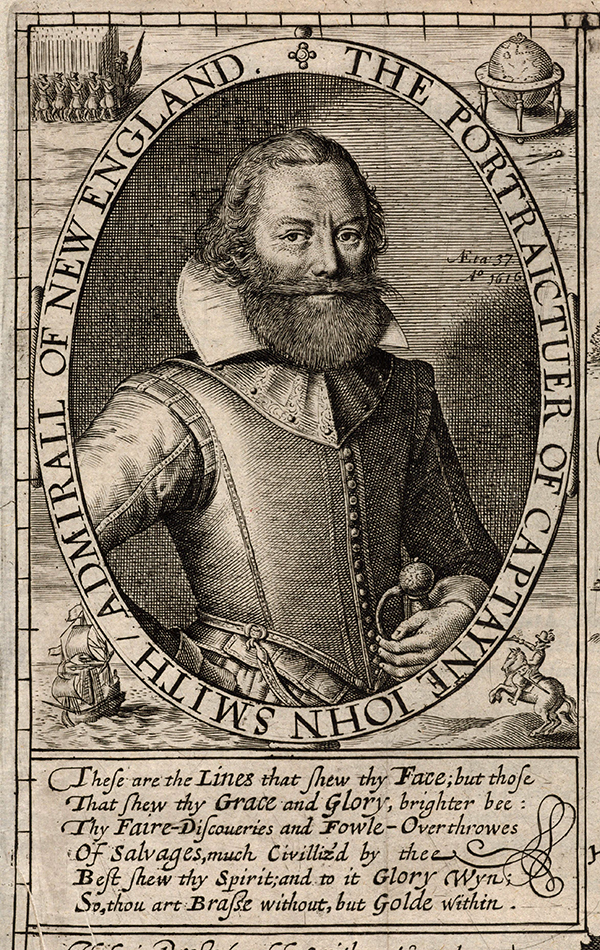Captain John Smith (1580 - 1631) was an English soldier, explorer, colonial governor, Admiral of New England, author, and self-promoter. He was pivotal in the establishment of the first permanent English settlement in America (Jamestown, Virginia) and was the first Englishman to map the Chesapeake Bay, and the coast of New England. His maps of these areas, especially his mapping of the Chesapeake, were broadly influential: there are few maps of Virginia that were produced in the 17th century that do not derive from his work. His books describing the Virginia Colony were themselves important in encouraging further settlement.
Smith was born to a farming family in Lincolnshire; after his father's death, he began his military career as a mercenary, fighting with the French at war with Spain. He was intermittently a merchant and a pirate in the Mediterranean, where his travels brought him into the fight against the Ottoman Turks. He fought for the Austrian Habsburgs in Hungary, and fought for Radu Șerban in Wallachia against Ottoman vassal Ieremia Movilă. His coat of arms - featuring three Turkish heads - was itself a gruesome memento of Smith's reputedly killing and beheading of three Ottoman challengers in single-combat duels. His fortunes turned in 1602, which saw him captured and enslaved by the Crimean Tatars, captured, and sold as a slave - a condition which apparently lasted only long enough for him to escape to Muscovy, thence to take the scenic route back to England in 1604.
In 1606, Smith was sent as one of the leaders of London's Virginia Company's effort to colonize Virginia. Over the course of the next year, as some sixty percent of the settlers died of starvation and disease, Smith explored Chesapeake Bay and its vicinity, producing his seminal, wildly influential map which would be eagerly copied by mapmakers throughout the next century. Preserved on this map was also a body of water, reported to Smith by Native Americans, which he believed to be either a massive lake, or the Sea of Verrazano - in short, the Pacific. He was forced to return to England in 1609 following his injury in a gunpowder explosion in his canoe. While in England, Smith passed on a tip on this possible Pacific passage to Henry Hudson, who would gain no joy of it.
Smith did not return to Virginia. He did, however, return to America, exploring the coast of New England in 1614. (This name was his own; Smith's New England would be the first map to employ that appellation.) Smith's 1614 journey was meant to capture whales for their oil, and to find gold or copper mines. Failing these, they found instead fish and furs. It is also very likely that in his exploration of the northeastern coast, Smith was the same Sea of Verrazano that so tantalized Hudson.
A difficulty with Smith's biography is that so much of it relies entirely on his own report: and Smith does not at all appear to have been a modest man.
Smith was born to a farming family in Lincolnshire; after his father's death, he began his military career as a mercenary, fighting with the French at war with Spain. He was intermittently a merchant and a pirate in the Mediterranean, where his travels brought him into the fight against the Ottoman Turks. He fought for the Austrian Habsburgs in Hungary, and fought for Radu Șerban in Wallachia against Ottoman vassal Ieremia Movilă. His coat of arms - featuring three Turkish heads - was itself a gruesome memento of Smith's reputedly killing and beheading of three Ottoman challengers in single-combat duels. His fortunes turned in 1602, which saw him captured and enslaved by the Crimean Tatars, captured, and sold as a slave - a condition which apparently lasted only long enough for him to escape to Muscovy, thence to take the scenic route back to England in 1604.
In 1606, Smith was sent as one of the leaders of London's Virginia Company's effort to colonize Virginia. Over the course of the next year, as some sixty percent of the settlers died of starvation and disease, Smith explored Chesapeake Bay and its vicinity, producing his seminal, wildly influential map which would be eagerly copied by mapmakers throughout the next century. Preserved on this map was also a body of water, reported to Smith by Native Americans, which he believed to be either a massive lake, or the Sea of Verrazano - in short, the Pacific. He was forced to return to England in 1609 following his injury in a gunpowder explosion in his canoe. While in England, Smith passed on a tip on this possible Pacific passage to Henry Hudson, who would gain no joy of it.
Smith did not return to Virginia. He did, however, return to America, exploring the coast of New England in 1614. (This name was his own; Smith's New England would be the first map to employ that appellation.) Smith's 1614 journey was meant to capture whales for their oil, and to find gold or copper mines. Failing these, they found instead fish and furs. It is also very likely that in his exploration of the northeastern coast, Smith was the same Sea of Verrazano that so tantalized Hudson.
A difficulty with Smith's biography is that so much of it relies entirely on his own report: and Smith does not at all appear to have been a modest man.





